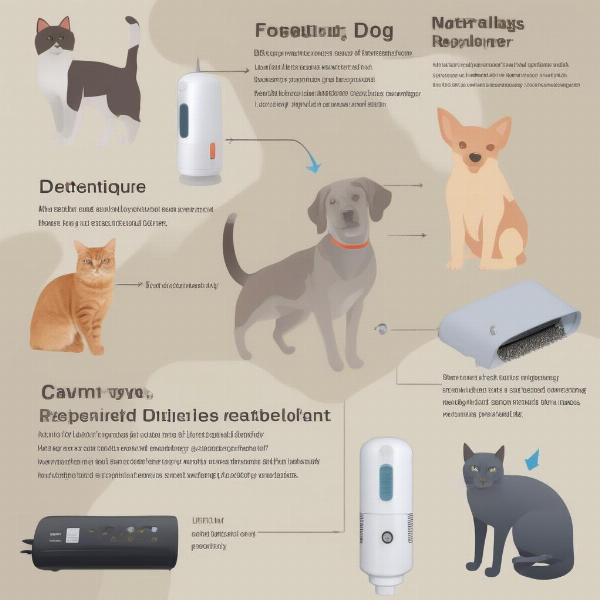A cat and dog repeller can be a valuable tool for protecting your garden, deterring strays, or even managing your own pet’s boundaries. Whether you’re dealing with neighborhood cats using your flowerbeds as a litter box or persistent dogs digging up your prized roses, a cat and dog repeller offers a humane and often effective solution. This article will explore the various types of repellers available, their effectiveness, and how to choose the best one for your specific needs.
Understanding Cat and Dog Repellers
Cat and dog repellers work by using various stimuli to deter animals from entering a designated area. These stimuli can range from ultrasonic sounds that are unpleasant to animals but inaudible to humans, to motion-activated sprinklers that startle them away. Some repellers also utilize scent-based deterrents, although these are generally less effective than other methods. Choosing the right repeller depends on several factors, including the target animal, the size of the area you want to protect, and your budget.
 Different Types of Cat and Dog Repellers
Different Types of Cat and Dog Repellers
Types of Cat and Dog Repellers
Ultrasonic Repellers
These devices emit high-frequency sounds that are irritating to cats and dogs but typically inaudible to humans. They are effective for small to medium-sized areas and are relatively inexpensive. However, their effectiveness can be limited by obstacles such as walls or fences.
Motion-Activated Sprinklers
These repellers use a motion sensor to detect animals and spray a burst of water to scare them away. They are effective for larger areas and can be particularly useful for deterring digging and other destructive behaviors. However, they require a water source and may not be suitable for all climates.
Scent-Based Repellers
These repellers use scents that are unpleasant to cats and dogs. While some may find success with this method, scent-based repellers are generally considered the least effective option, as the scents can dissipate quickly and may not be strong enough to deter determined animals.
Choosing the Right Repeller
Consider the following factors when choosing a cat and dog repeller:
- Target Animal: Some repellers are more effective on cats than dogs, and vice-versa.
- Area Size: Ultrasonic repellers are suitable for smaller areas, while motion-activated sprinklers are better for larger spaces.
- Power Source: Some repellers are battery-operated, while others require a power outlet.
- Weather Resistance: If you plan to use the repeller outdoors, make sure it is weather-resistant.
Tips for Effective Use
- Placement is Key: For ultrasonic repellers, ensure there are no obstacles blocking the sound waves. For motion-activated sprinklers, position them to cover the area you want to protect.
- Consistency is Important: Use the repeller consistently to reinforce the negative association for the animal.
- Combine Methods: For optimal results, consider combining different types of repellers, such as using both an ultrasonic repeller and a motion-activated sprinkler.
“A common mistake people make is not using the repeller consistently,” says Dr. Emily Carter, a certified veterinary behaviorist. “Animals learn through association, so consistent use is crucial for creating a negative association with the protected area.” Another expert, Dr. Sarah Miller, adds, “Understanding the specific needs of your situation, like the target animal and the size of the area, will help you choose the most effective repeller.”
Conclusion
A cat and dog repeller can be a valuable tool for protecting your property and managing animal behavior humanely. By understanding the different types of repellers available and choosing the right one for your specific needs, you can effectively deter unwanted animals and maintain a peaceful and enjoyable outdoor space. Remember to consider the target animal, area size, and other factors when making your decision.
FAQs
- Do cat and dog repellers harm animals? No, most repellers use harmless stimuli like ultrasonic sound or water to deter animals.
- Are ultrasonic repellers effective on all animals? While effective on many cats and dogs, their effectiveness can vary depending on the animal’s age, hearing ability, and individual sensitivity.
- How long does it take for a repeller to work? It can take several days or even weeks for a repeller to effectively deter animals. Consistency is key.
- Can I use a cat and dog repeller indoors? Yes, some repellers are designed for indoor use, particularly for managing pet behavior within the home.
- What if my dog barks at the ultrasonic repeller? Some dogs may initially bark at the sound, but they typically habituate to it over time.
- Do motion-activated sprinklers waste water? They use a short burst of water, so water usage is minimal compared to traditional sprinklers.
- Where can I purchase a cat and dog repeller? Repellers are available at most pet stores, garden centers, and online retailers.
dog and cat repeller
dog repeller device
sonic dog repeller
tick yard spray safe for dogs
ILM Dog is a leading international website dedicated to providing expert advice on dog care and well-being. We cover a wide range of topics including breed selection, health and medical care, training and behavior, nutrition, grooming, and product recommendations. For expert advice and support, contact us via email at [email protected] or phone at +44 20-3965-8624. ILM Dog is here to help you provide the best possible care for your canine companion.